
Volcano Facts for Kids: Fun & Explosive Learning Adventure!
Table of Contents
Volcano Facts: What do you think about when it comes to volcanoes? Do you know what are they? How are they formed? Have you ever seen a volcano? Let’s learn all about volcanoes in this lesson!
What Is a Volcano?
Volcanoes are openings in the Earth’s surface. A volcano is a landform, that is usually a mountain, where molten rock erupts through the surface of the planet.
The Main Parts of a Volcano
1. Magma
It is the hot liquid rock inside the volcano.
2. Magma Chamber
It is a large pool of magma found underneath the Earth’s crust.
3. Lava
It is the name given to magma when it flows outside the volcano.
4. Vent
It is an opening in Earth’s surface that the volcano erupts through.
5. Crater
It is the mouth of a volcano, and it surrounds the vent.
6. Conduit
It is a passage beneath the ground that magma travels through.
7. Throat
It is the entrance of a volcano, or the part of the conduit that ejects lava and ash.
8. Flank
It is the side of a volcano.
9. Summit
It is the peak or the highest point of a volcano.
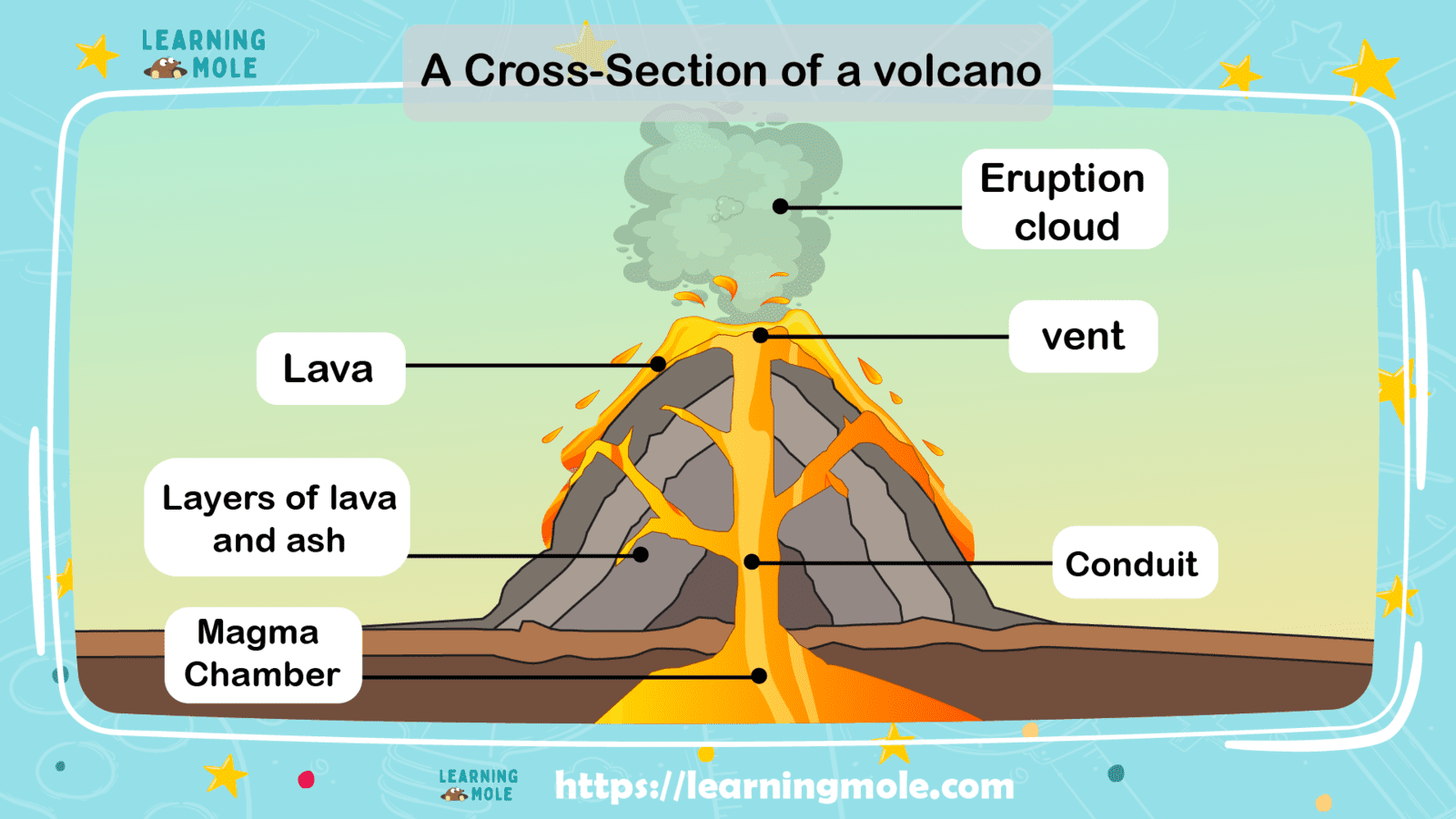
How Do Volcanoes Form?
The Earth is made up of four layers: inner core, outer core, mantle and crust. The mantle and crust are a thin skin compared to the other layers. The mantle is about 1,800 miles thick, while the crust is only about 8 miles thick. The crust and the upper mantle together are called the lithosphere. This layer is considered the surface of the Earth, but it is not one solid piece. It is broken into pieces of rock masses called “tectonic plates”.
The plates are always moving and pushing into each other, but they move so slowly that we do not feel it. The edges where two plates meet are called plate boundaries. Most volcanoes on the Earth’s surface form at plate boundaries.
Types of Plate Boundaries
Each different type of plate boundary causes something different to occur.
1. Convergent Boundaries
At these boundaries, two plates move towards each other. In other words, they are being pushed together. Old crust either moves down into the mantle, where it melts, or moves up, where it forms mountain ranges.
2. Divergent Boundaries
At these boundaries, two plates separate and move away from each other. In other words, they are being pushed apart. This creates a new crust between the two plates.
3. Transform Boundaries
At these boundaries, two plates slide horizontally past each other. In other words, they move side by side. This does not destroy or create new crust. These are often called faults.
Where Do Volcanoes Form?
1. Convergent Plate Boundaries
When plates are pushed together, some of Earth’s crust is pushed deeper into the mantle. There, it melts and becomes magma, and then it rises to the surface again to form volcanoes. Convergent plate movement often forms chains of volcanoes.
2. Divergent Plate Boundaries
When plates are pushed apart, openings in the Earth’s crust allows molten rock (magma) to escape, forming volcanoes. Here, the magma rises from the mantle. Then, it turns into solid rock when it cools, forming a new crust.
3. Hotspots
There are areas on Earth’s surface above columns of hot magma called mantle plumes. Heat from the mantle plume melts the thin crust, and magma pushes up to the surface creating a volcano. So, volcanoes can form above a mantle plume. Hotspots may be far from tectonic plate boundaries.
Volcanoes do not usually form at transform boundaries because there is little or no magma at them.
Volcanic Eruption
When a volcano erupts, lava from deep within Earth escapes up to the surface and flows down the mountain. Hot ash and gases are thrown into the air. Some volcanoes are covered with snow and ice. If they erupt, melted snow and ice mixes with mud and volcanic ash, and then flows down the mountain.
Eruptions can cause lateral blasts, lava flows, hot ash flows, mudslides, avalanches, falling ash and floods. Volcano eruptions have been known to knock down entire forests. An erupting volcano can also cause tsunamis, floods and earthquakes.
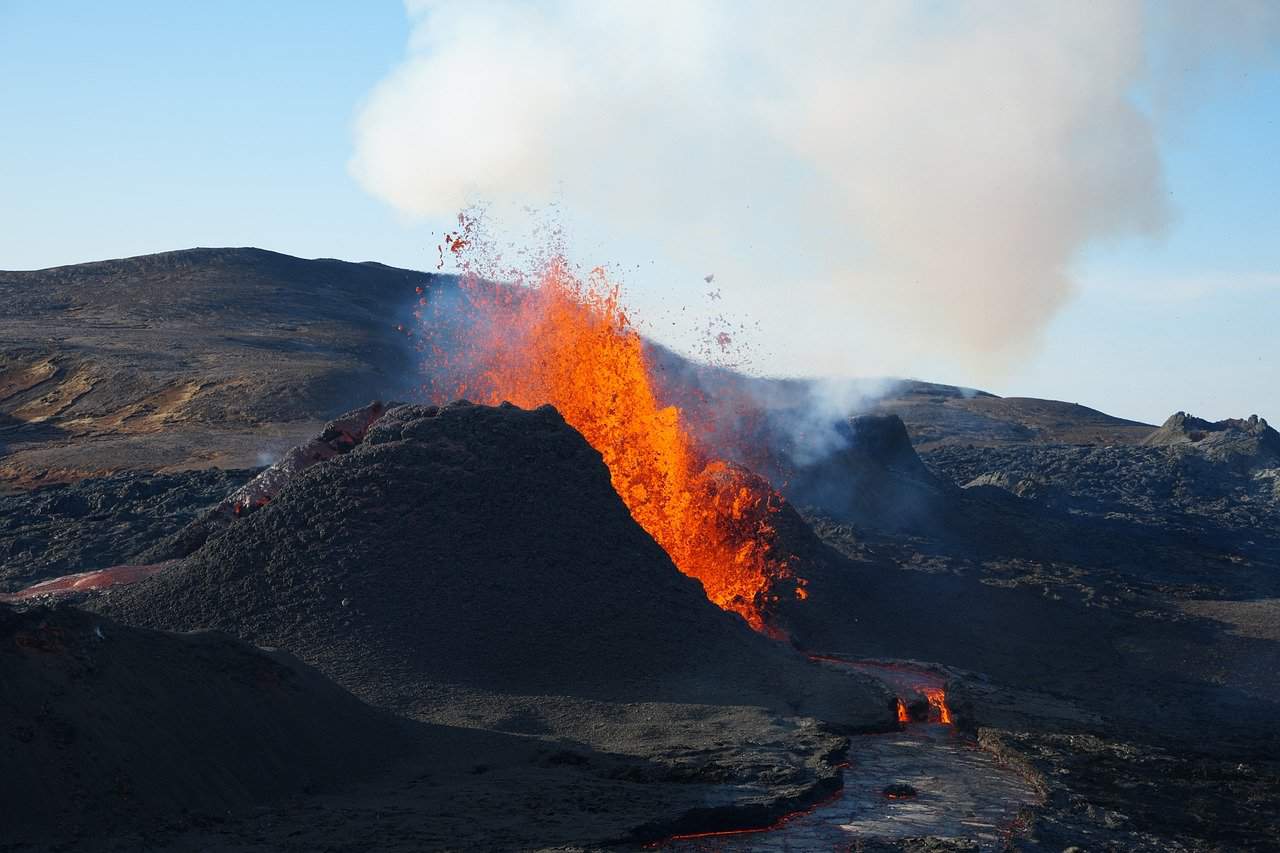
Types of Volcanoes
There are many different types of volcanoes depending on the lava and other volcanic materials that come out of them. However, there are two basic, or main, types: shield volcanoes and composite volcanoes (or stratovolcanoes).
1. Shield Volcanoes
Shield volcanoes are wide volcanoes shaped like a bowl with gentle sloping sides. They are formed by layers of fluid, or low-viscosity, lava that flows and spreads out to give the volcano the sloping sides. Shield volcanoes do not grow to a great height.
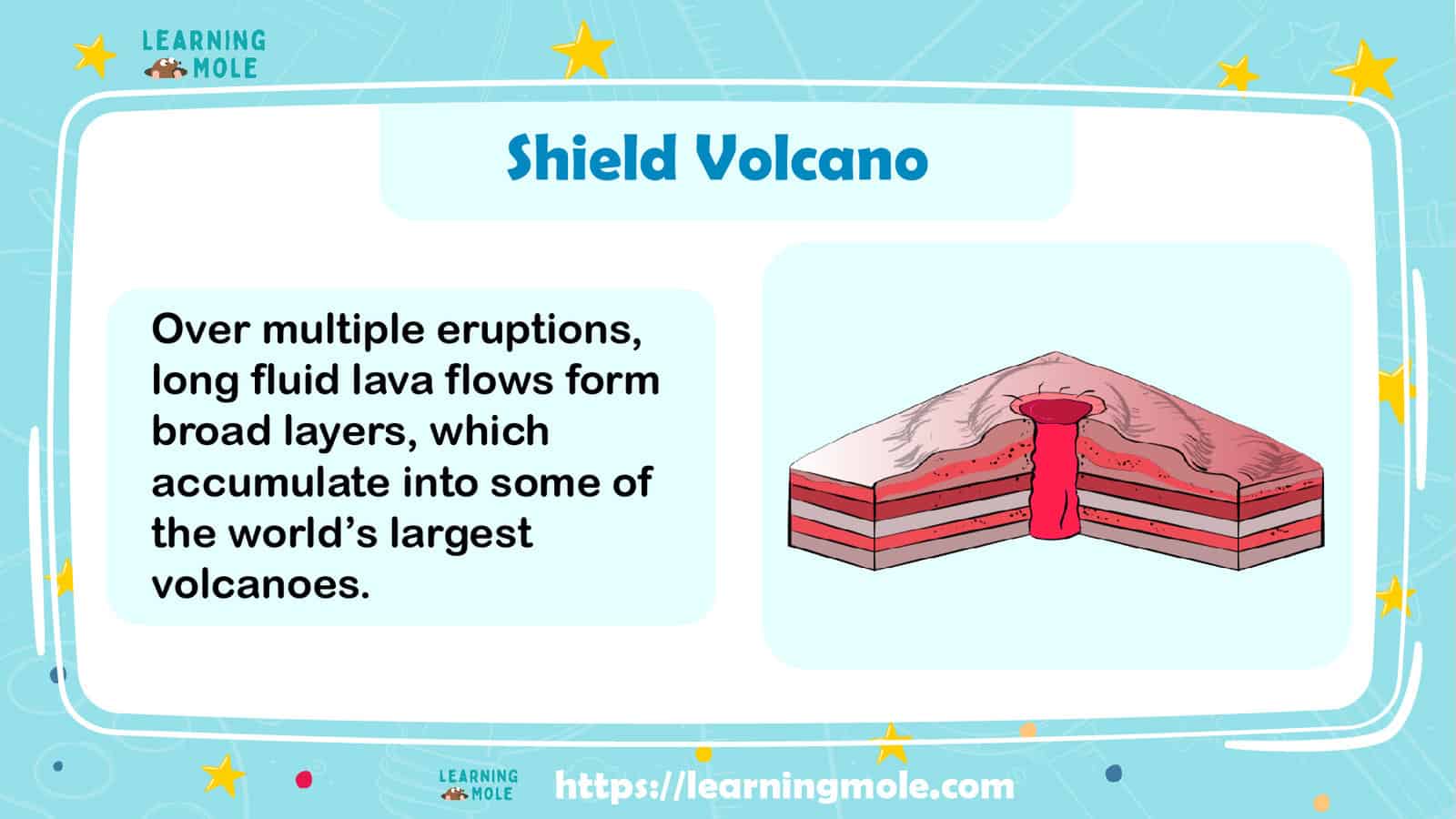
2. Composite Volcanoes (Stratovolcanoes)
Stratovolcanoes, also called composite volcanoes, are volcanoes shaped like cones with steep sides. They are formed by layers of sticky, or high-viscosity, lava that has turned into rock. This lava cools and hardens before it spreads far. Composite volcanoes are very tall.
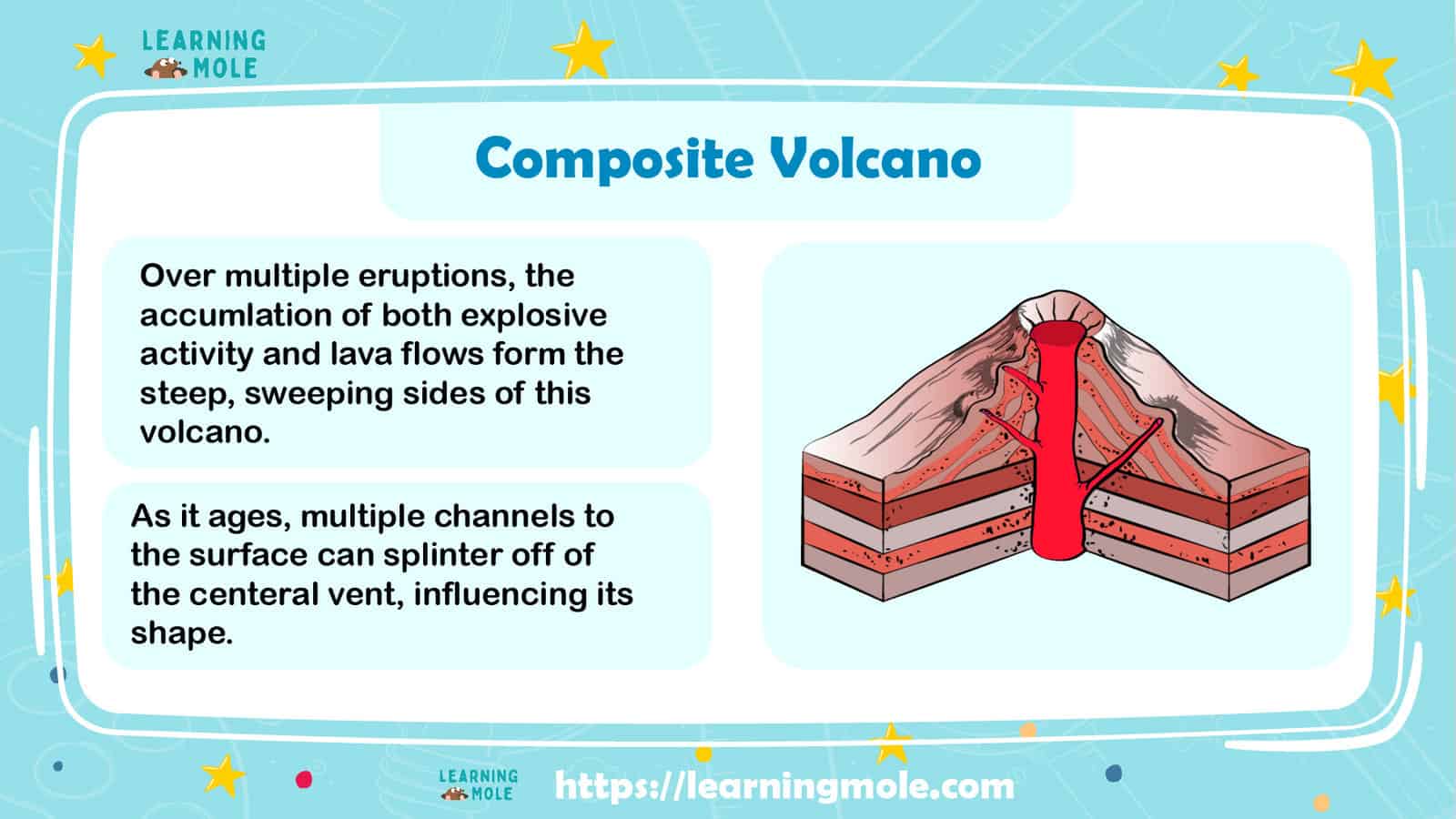
Stages of Volcanoes
There are three main stages of volcanoes out there according to the amount of volcanic activity (eruption). The stages are the active, the dormant and the extinct.
- An active volcano is one which has recently erupted and there is a possibility that it may erupt soon. Mauna Loa in Hawaii is an example of an active volcano.
- A dormant volcano is one which has not erupted in a long time but there is a possibility it can erupt in the future. Mauna Kea in Hawaii is an example of a dormant volcano.
- An extinct volcano is one which erupted thousands of years ago and there is no possibility that it may erupt soon. Edinburgh Castle in Scotland is located on the remnant of a volcano that went extinct many millions of years ago.
Volcano Effects
Hazard
Volcanic eruptions are a threat to humans as they are very dangerous. Soma natural disasters often accompany volcano eruptions, such as earthquakes, mud pots, hot springs and geysers. Gases from volcanoes can reach the atmosphere of Earth and affect our climate. They can also damage the Ozone layer and cause acid rain.
Benefits
Although volcanoes are very dangerous, volcanic activity has benefited humans in many ways. For example, lava and ash from volcanoes are rich in nutrients that are important to the soil, so they help produce rich and fertile land over time. Volcanic ash also forms rocks that are used in construction. In addition, volcanic activity provides valuable mineral resources, such as metal ores.
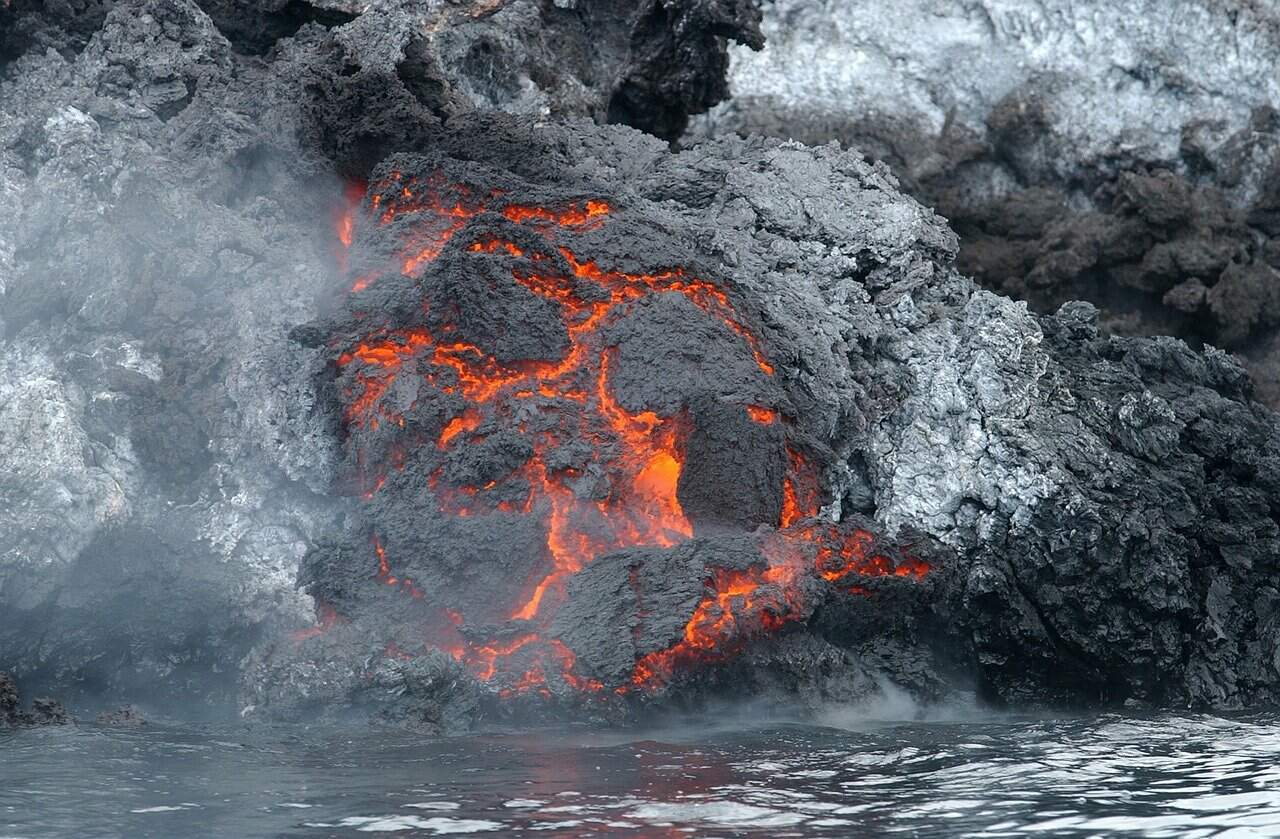
How Many Active Volcanoes Are There in the World?
There are about 1350 active volcanoes in the world other than those on the ocean floor, which could be about 10,000. Many volcanoes are found in the “Ring of Fire” zone in the Pacific Ocean. There are actually more than 450 volcanoes in the Ring of Fire.
The Ring of Fire
Most volcanoes on Earth are located in an area in the Pacific Ocean called the “Ring of Fire”. This area is where most earthquakes and volcanic eruptions occur. In other words, the Ring of Fire is the most seismically and volcanically active zone in the world. In fact, the Andes Mountains are located in the Ring of Fire, and they include the highest active volcano in the world, which is Ojos del Salado.
The Ring of Fire is located around the edges of the Pacific Ocean. It is formed by movements of tectonic plates. It is about 40,000 kilometres long and about 500 kilometres wide. There are about 15 countries that the Ring of Fire stretches across. These countries include Indonesia, New Zealand, Papua New Guinea, Philippines, Japan, United States, Chile, Canada, Guatemala, Russia, Peru, Solomon Islands, Mexico and Antarctica.
Countries with the Most Active Volcanoes
Indonesia is the country that contains the largest number of volcanoes in the world. There are 147 volcanoes in Indonesia, 129 of which are active. In fact, about 13% of the world’s active volcanoes are actually in Indonesia. The reason why Indonesia has so many volcanoes is because it is like a meeting point of several tectonic plates. The movements of those plates caused so many volcanoes to form.
After Indonesia comes Chile with the second largest number of volcanoes. There are about 2000 volcanoes in Chile, about 122 of which are active. In fact, the highest active volcano in the world, Ojos del Salado, is in Chile.
In third place comes Japan. It has around 110 active volcanoes. In fact, the tallest mountain in Japan, Mount Fujiyama, is an active volcano that last erupted in 1707.
The Largest Volcano on Earth
The largest known volcano on Earth is Tamu Massif. Tamu Massif is an extinct shield volcano located on the seafloor in the Pacific Ocean. The volcano covers an area of about 553,000 square kilometres, and it is about 4,460 metres tall. Tamu Massif became extinct about 100 million years ago.
The Largest ACTIVE Volcano on Earth
Mauna Loa in Hawaii is the largest active volcano on our planet, rising to more than 4 kilometres (2.5 miles) above sea level. Its underwater sides descend to the sea floor for 5 kilometres (3 miles). In addition, the volcano’s great mass pushes down and lowers the sea floor 8 kilometres (5 miles). So, the volcano’s peak is about 17 kilometres (10.5 miles) above its base. Mauna Loa has erupted 33 times since 1843, and it last erupted on 15 April, 1984.
Five Deadliest Volcanic Eruptions in Human History
1. Mount Tambora, 1815
It is the largest and the deadliest volcanic eruption in history. The eruption occurred in 1815 at Mount Tambora on Sumbawa Island, which is a part of Indonesia now. The eruption and the tsunami that it caused killed around 100,000 people, but there were more people who died because of the eruption’s other effects over the next several years.
The volcano blew up so much ash and gases into the atmosphere that it affected the Earth. The sky darkened and the gases in the atmosphere prevented some amounts of sunlight from reaching Earth’s surface. This resulted in a decrease in the average temperature on Earth. A large number of people died because of famine and diseases as crops could not grow.
2. Krakatau, 1883
The second largest and deadliest volcanic eruption in history. The eruption occurred in 1883 in Krakatoa, an island in Indonesia. The sound of the explosion was the loudest sound ever heard in human history.
The eruption destroyed two-thirds of the island and caused very high tsunami waves. It also ejected ash into the atmosphere that blocked the Sun slightly and caused changes in climate that caused the average global temperature to decrease for a while. Krakatau volcanic explosion killed at least 36,000 people. Krakatau is still active, but its eruptions are not dangerous anymore.
3. Mount Pelée, 1902
Mount Pelée erupted in 1902 on the island of Martinique, France, and it was one of the deadliest volcanic eruptions ever. The volcano caused heavy ash-fall that sometimes darkened the sky totally. Within minutes, the eruption caused the town to perish and killed almost all of its residents, who were around 30,000 people.
4. Mount Ruiz, 1985
Mount Ruiz is a volcano in the Andes Mountains of Colombia. When it erupted in 1985, it ejected so much gases, mud and ash down the mountain. The eruption caused huge mudflows that flooded Armero, a nearby town, and killed around 22,000 of its residents, who were almost 29,000 originally. It also caused a mudslide that destroyed another town called Chinchiná and killed around 1,000 people more. So, there were at least 23,000 deaths because of the volcanic eruption.
5. Mount Unzen, 1792
Mount Unzen is located in western Kyushu, Japan. Its eruption in 1792 was the deadliest volcanic eruption in Japan’s history. The eruption caused an earthquake that in turn led to a huge landslide. This landslide swept through a city called Shimabara, and reached the Ariake Sea. Reaching the sea, it caused a tsunami that destroyed the nearby areas. This event killed around 15,000 people, most of them died because of the landslide and the tsunami.
How to Stay Safe in a Volcanic Eruption
Volcanoes are very dangerous, either because of the material they eject or because of the disasters that they may cause. So, it is important to know some safety tips to follow in case a volcano is threatening to erupt.
Preparing Before a Volcanic Eruption
Volcanoes sometimes give warnings before they erupt. For example, there could be some earthquakes, or the flanks of the volcano bulges. So, if you live near a volcano, pay attention to these signs, and always listen to the radio and news for any updates. It is also important to know the evacuation routes and plans in case a volcano erupts.
Safety Tips During an Eruption
- Follow instructions and orders from the authorities.
- Evacuate and leave the area of danger as fast as possible.
- If there is an ash-fall, stay indoors and close all the doors and windows.
- If you are outside, seek shelter indoors.
- If there is a heavy ash-fall, avoid driving a vehicle.
- If you have any pets or animals, bring them into closed shelters.
- Try to wear long-sleeved shirts and long pants.
- If you are near a stream or river, be aware of rising water and mudflows that could occur. Try to move up as much as possible.
Safety Tips After an Eruption
- Listen to the officials to know when it is safe to move. If you are indoors, do not go outside until it is safe.
- Avoid contact with ash.
- If you are to remove ash from your roof, be careful. Ash makes surfaces slippery.
- Wear protective clothes when cleaning up.
- Children should not help with the cleaning up process.
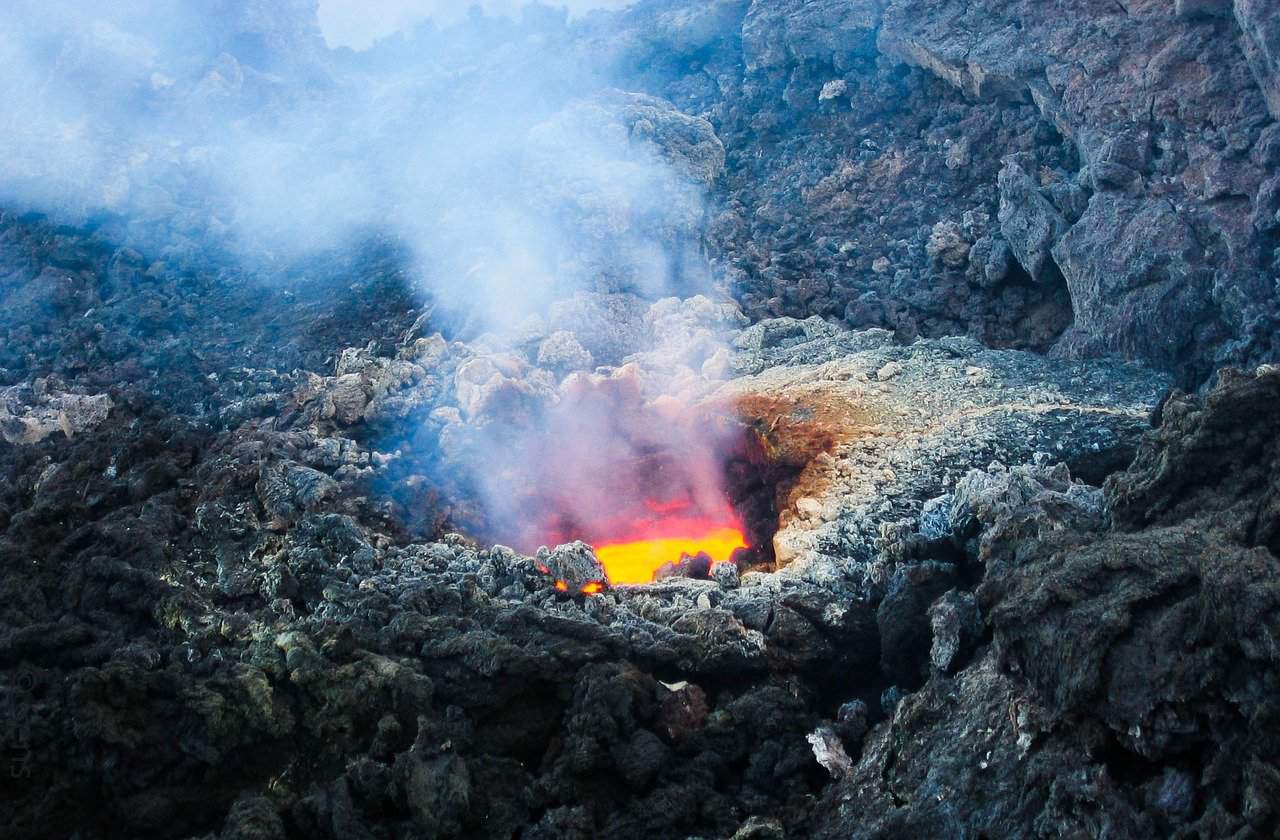
12 Interesting Volcano Facts
- The word “volcano” is derived from the Roman name “Vulcan”, who was the god of fire in Roman mythology.
- Lava is very hot. It reaches up to 1,250° C. It glows red as it flows out of the volcano. When it cools, it hardens into rock.
- Volcanoes are not only found on Earth, but also on other planets and moons in the Solar System.
- The largest volcano in the Solar System is Olympus Mons on planet Mars.
- Planet Jupiter’s moon, Io, is the most volcanically active object in the Solar System. It has more than 400 active volcanoes.
- The Ring of Fire is named so because of the several volcanoes that it has.
- More than 80 percent of the Earth’s surface, whether on land or under the sea, is of volcanic origin.
- Many volcanic eruptions over time have made mountains, plateaus and plains on Earth’s surface.
- Around 350 million people live in areas that are at risk of volcanic eruptions.
- People set up homes on the slopes of volcanoes because of the rich, fertile soil there.
- Maleo birds bury their eggs in the sand or soil near volcanoes to keep them warm.
- The branch of geology that studies volcanoes is called volcanology.
FAQ
Q: Are all volcanoes dangerous?
A: While volcanoes can be destructive during eruptions, they also have many positive impacts. They can create fertile soil for agriculture, contribute to geothermal energy resources, and even shape landscapes and ecosystems. Remember, it’s important to learn about volcanic safety measures if you live near a volcano.
Q: Can we predict when a volcano will erupt?
A: Scientists are constantly working on improving their ability to predict volcanic eruptions. While it’s not always possible to pinpoint the exact time, monitoring volcanic activity can help provide warnings and prepare communities for potential risks.
Q: Where can I learn more about volcanoes?
A: There are many resources available to learn more about volcanoes! You can visit museums with exhibits on volcanoes, read books or articles, watch educational documentaries, or even explore websites and apps dedicated to volcanoes.
Conclusion
Volcanoes are awe-inspiring and powerful natural wonders. By understanding how they form, erupt, and impact our world, we can appreciate their complex nature and importance in shaping our planet. Remember, volcanoes can be both destructive and beneficial, and learning about them allows us to appreciate their unique role in our world.


Leave a Reply